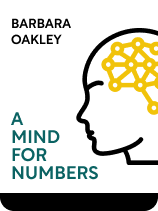

This article is an excerpt from the Shortform book guide to "A Mind for Numbers" by Barbara Oakley. Shortform has the world's best summaries and analyses of books you should be reading.
Like this article? Sign up for a free trial here .
What are the two modes of thinking? Can you deliberately alternate between them?
Your brain naturally alternates between two modes of thinking: focused thinking and diffuse thinking. You can learn to switch between these two modes in order to solve problems.
Read more to learn when and how to alternate between modes of thinking.
Alternate Between Modes of Thinking to Solve Difficult Problems
According to Oakley, solving any difficult problem requires an exchange of information between your brain’s focused-mode and diffuse-mode functions. Sometimes multiple cycles are required. So start by deliberately focusing on the problem and then deliberately divert your attention, allowing your brain to switch to diffuse mode. Repeat as needed, alternating between modes until you solve the problem.
| Perspectives on Alternating Between Modes of Thinking Other authors echo Oakley’s imperative to alternate between modes of thinking, but each seems to offer a different rationale for it: To Oakley, it’s a matter of detail. Your diffuse mode can see the big picture and generate creative solutions to the problem at hand, but only your focused mode can flesh it out with enough detail to make it work. To De Bono, it’s a matter of selection. Use lateral thinking (diffuse mode) to generate possible solutions, then use vertical thinking (focused mode) to analytically select the best one. To Kahneman, it’s a matter of consequences and mental resources. System 1 (diffuse mode) operates automatically, but is prone to bias errors. System 2 (focused mode) consumes your limited mental energy, but can correct these errors. Thus, you operate in diffuse mode by default and switch to focused mode to analyze your diffuse mode’s suggestions, investing more mental resources in your analysis when the consequences of the decision are more significant. Gladwell might argue that, at least in some cases, you don’t need to switch back to conscious thinking (focused mode) to solve a problem if you’ve adequately conditioned your brain’s unconscious (diffuse) mode for that type of problem. A case study supporting this assertion is that of Hyram Rickover, an engineer with remarkable intuition. In The Rickover Effect, Theodore Rockwell describes Rickover’s involvement in the design of the cooling system for the first nuclear-powered submarine. Engineers initially performed a detailed analysis to determine the size of the cooling system, but when Rickover saw the result, he insisted it was too small. Based on his intuition, he ordered them to quadruple the capacity of the cooling system. When the submarine was finished, the cooling system proved adequate but not excessive: In this case, Rickover’s engineering intuition was more accurate than the detailed thermodynamic analysis. That said, A Mind for Numbers focuses on learning subjects like engineering, not applying that subject knowledge later. Rickover’s intuition had been conditioned by many years of experience, which you typically don’t have when you enroll in your first thermodynamics class. And professors usually expect you to show your work, so writing down an answer based on intuition may not get you many points on an exam, even if your answer is close enough for practical purposes. Thus, Oakley and Gladwell would probably agree that, as a student, working out solutions in focused mode is a safer bet. Plus, it provides a good starting point for calibrating your intuition on those kinds of problems. |
When to Switch From Focused to Diffuse Mode
Oakley recommends that you continue to focus on the problem as long as you are making progress, whether in solving it or just in understanding it. When you cease to make progress or become frustrated, switch to diffuse mode.
Oakley points out that sometimes people around you can sense nuances of your behavior and measure your level of frustration more accurately than you can. For example, maybe your spouse notices that you are typing more forcefully as you try to finish a report and invites you to take a break. Or maybe your study partner sees the tension rising in your facial expression and suggests a run to the cafeteria for a snack before tackling the rest of your physics homework. Listen to them.
(Shortform note: Turning this around, sometimes, you can help your study partners by suggesting a break when you see them becoming frustrated. In Emotional Intelligence 2.0, Bradberry and Greaves present tactics for reading people’s emotions. In particular, they note that raised shoulders or fidgety hand movements can be signs of distress or frustration.)
Is there ever a time when you should switch to diffuse-mode thinking before you stop making progress or start to become frustrated? Oakley would probably say yes: Although she doesn’t bring it up in the context of alternating between thinking modes, elsewhere in the book, she does highlight the importance of avoiding burnout by scheduling time for rest and relaxation. She points out that you can accomplish more by working at a sustainable pace and giving your diffuse mode time to operate than by spending too much time in focused mode and then suffering reduced productivity because you’re mentally exhausted.
When to Alternate Between Modes of Thinking
Oakley notes that the interval over which you alternate modes also affects your problem-solving. On the one hand, since diffuse-mode problem solving only operates on information leftover from focused-mode thinking, it can run out of information if you go too long between focused-mode sessions. Oakley recommends that, as a rule of thumb, you should refocus on the problem at least once a day.
| Rapid Transitions to Diffuse Mode To take full advantage of diffuse mode, you need to divert your attention from the problem until it no longer lingers in your conscious mind. How long does this take? Oakley says it typically takes several hours. This seems reasonable for many situations, but it seems like there could be exceptions. For example, suppose you have been studying physics in your dorm room for some time when suddenly you hear a gunshot outside. The subject of physics vanishes instantly from your mind. Does a sudden shift in mental focus like this result in more time-efficient alternation between focused and diffuse thinking modes? Or does it purge the information from your conscious mind too fast for your diffuse mode to absorb it, making the diffuse-mode processing ineffective? Oakley does not address this question, and it is unclear to what extent this possibility has been investigated by the scientific community. Either way, your diffuse mode would finish processing the data sooner, whether because it received less information or got a head start on processing it. According to Oakley, once your diffuse mode has finished processing, it’s time to switch back to focused mode. Thus, we infer that you should refocus on the problem sooner after a sudden transition to diffuse mode than after a gradual one. |
How to Switch Between Modes of Thinking
Oakley doesn’t provide instructions for switching your brain to focused-mode thinking. She doesn’t need to, because, as she points out, focused mode activates automatically when you focus on something.
Deliberately switching to diffuse mode is a bit less intuitive, but Oakley presents several practical methods for diverting your focus so that your diffuse mode can operate. Here are a few methods from her list:
Go for a walk or do something athletic. Oakley states that physical activity is particularly effective for stimulating diffuse-mode thinking, and also promotes the generation of new neurons and neural pathways in your brain.
| The Body-Brain Connection The connection between physical exercise and mental health is a common theme among many self-help authors. While Oakley applies this principle to academics, Brenden Burchard applies it to professional productivity in High Performance Habits. Improving your health is one of the six habits Burchard identifies that contribute to improving your performance. He asserts that regular exercise, combined with a healthy diet and adequate sleep, will give you greater mental energy and mental clarity. Meanwhile, Robin Sharma applies this principle to man’s quest for happiness, balance, and fulfillment in The Monk Who Sold His Ferrari. On the grounds that improving your mind will improve your body and improving your body will improve your mind, Sharma develops his “Ritual of Physicality” as one of his “Ten Rituals for Radiant Living.” This ritual consists of exercising for at least five hours per week, plus practicing deep-breathing exercises for a few minutes a few times each day. Kelly McGonigal expands upon how exercise benefits mental health, happiness, and even relationships in The Joy of Movement. She observes that during physical exercise, your muscles produce chemicals called myokines, which circulate through your bloodstream. These myokines stimulate various parts of your body, including your brain. They increase your cognitive performance, as well as alleviating both physical pain and emotional depression. |
Take care of routine tasks. Do housework or yard work, take a bath or do laundry, feed your pets, or work on other chores that don’t require intensive focus. Oakley notes that this approach is especially useful because we all have limited time: It allows you to apply diffuse mode thinking to complex problems and simultaneously make progress on other tasks that you need to complete.
(Shortform note: There are other benefits of this tactic as well. A recent study by Smith, Ng, and Popkin concluded that housework is a feasible means for workers with sedentary jobs and limited time to get the health benefits of physical activity. And psychologists such as Vivian Wolsk assert that these chores can also serve a therapeutic purpose by relieving stress and providing a sense of accomplishment.)
Rest and reflect. Reflection includes prayer, meditation, listening to music, and so on. As to rest, Oakley suggests that if you’re pressed for time, just close your eyes for a moment to avert your attention and avoid the Einstellung effect. She bases this suggestion on research by Nakano et al that suggests just blinking may involve a momentary break in focus that allows your brain to reevaluate your situation.
If you’re not pressed for time, get some sleep. According to Oakley, diffuse-mode thinking continues to operate while you sleep, so it’s a great way to give your diffuse mode time to operate. Sleep also plays an essential role in your brain’s ability to function: Oakley explains that when you’re awake, metabolic processes in your brain generate toxins that are expelled from the cells. When you sleep, your brain cells contract, increasing the space between cells. This allows the toxins to be washed out of the brain by cerebrospinal fluid and ultimately eliminated from the body.
Thus, Oakley cautions that if you don’t get enough sleep, the toxins in your brain can build up to the point where your brain can’t make all of the neural connections necessary for you to think normally. Consequently, one hour of studying with a well-rested brain will allow you to learn more than three hours of studying with a tired brain.
| The Importance of Sleep The importance of sleep for neurological health is echoed by numerous other authors. In Moonwalking with Einstein, Joshua Foer points out that sleep is important for consolidating information in your brain. He cites studies performed on rats, where the rats’ neurons fired identical patterns during a maze exercise and when sleeping after the maze exercise. Matthew Walker echoes this observation in Why We Sleep, asserting that sleep improves long-term memory of important facts, eliminates trivial information that would otherwise clutter up your memory, and enhances your motor-task proficiency. He also warns that lack of sleep impairs your ability to focus and to control your emotions, and increases your risk of Alzheimer’s disease. In Essentialism, Greg McKeown stresses that getting enough sleep makes you more productive because it allows you to perform at your highest level. He asserts that sleep enhances your creativity and problem-solving abilities. |

———End of Preview———
Like what you just read? Read the rest of the world's best book summary and analysis of Barbara Oakley's "A Mind for Numbers" at Shortform .
Here's what you'll find in our full A Mind for Numbers summary :
- How to make math and science intuitive
- Strategies for remembering complex concepts more easily
- How to build good study habits and avoid procrastination






